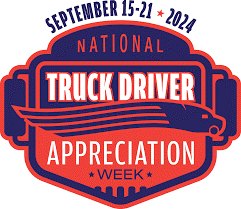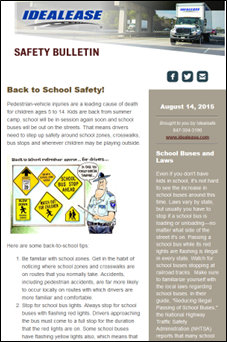Drive Sober or Get Pulled Over
Check out this week's Safety Bulletin! It's all about the crucial need for sober driving and ways you can stay extra vigilant on the roads. Don't miss out on important safety updates - subscribe now to receive all future bulletins directly to your inbox.
The "Drive Sober or Get Pulled Over" campaign is in full swing from August 16 to September 2, 2024. It's a crucial effort to promote safer roads by cracking down on impaired driving. As we approach Labor Day weekend, let's all contribute to making our roads safer. With more people traveling, it's important to be extra cautious and ensure that everyone has a safe journey. Let's work together to make our roads free from the dangers of impaired driving.
Labor Day Driving Trips from America's Road Team
The first step towards a safe trip begins in the driveway.
- Do a "walk around" before leaving: Check your vehicle's tires, wipers, and fluids. Have your radiator and cooling system serviced.
- Plan ahead: Before getting on the highway, know your exit by name and number, and watch for signs as you approach it. Drivers making sudden lane changes to exit often cause accidents.
- Get a map or program your GPS: Surprisingly, few motorists use maps, even when driving through unfamiliar areas. Knowing the road is essential for safe driving—it allows you to anticipate the road ahead and avoid a panicky search for directions.
- Leave early and avoid risks: Leave early so you won’t be anxious about arriving late and can accommodate any delays. Know your limitations: don’t drive when tired, upset, or physically ill. Never attempt risky maneuvers to gain a few seconds.
- Be aware of trucks’ blind spots: When sharing the road with large trucks, be mindful of their blind spots. If you can't see the truck driver in their mirrors, the driver likely can’t see you.
- Expect the unexpected: Look a quarter mile ahead for a safe path and always leave yourself an out.
- Stay hands-free: Ensure your phone is connected to your vehicle's Bluetooth, and use it hands-free. Limit cell phone use to a minimum, and pull off to a designated parking area if a call is prolonged. Never use your phone in work zones.
- Signal your intentions: Signal ahead of time when changing lanes so other drivers can respond. If a truck signals to change lanes, give it space—it may be avoiding another vehicle.
- Do not cut in front of large trucks: Trucks are heavier and take longer to stop, so avoid cutting quickly in front of them.
- Yield: On entrance ramps, remember that highway traffic has the right of way. Maintain proper speed, use smooth merging techniques, and don’t slow down in front of a truck.
- Never stop on the highway: The most dangerous speed on a highway is zero. Stopped vehicles, even on the shoulder, create severe hazards. If you must stop for an emergency, remember that big trucks may not be able to stop to assist you, but many will use their radios to contact the police or highway patrol.
- Watch your gas gauge: To save fuel, take direct routes, minimize side trips, and maintain a steady speed. A well-tuned engine, properly inflated tires, and reduced speed will result in noticeable fuel savings. Ensure you have at least a quarter tank of gas before getting on the highway. Traffic tie-ups can consume a lot of fuel and may leave you stranded.
- Stay alert in construction zones: Traffic may move more slowly, and lanes may be temporarily closed. Obey informational signs located within the work zone.
America’s Road Team would like to remind the motoring public that from driveway to highway, safety requires patience and dedication.
Is that a Drunk Driver?
- Problems in maintaining lane position: Look for signs of erratic steering or an inability to keep the vehicle in a lane. Weaving across lanes, straddling two lanes, or almost striking another vehicle are potential indicators of a drunk driver.
- Speed and braking problems: Braking smoothly becomes difficult for an impaired driver. Watch for general problems with stopping, such as jerkiness, stopping short or abruptly. Maintaining a consistent speed is also challenging for drunk drivers, so look for drivers who accelerate and decelerate quickly or drive well below the posted speed limit.
- Vigilance problems: This refers to a driver’s inability to pay attention to driving. An impaired driver might forget simple things that a sober driver would not, such as driving at night without headlights, driving the wrong way on a one-way street, or responding slowly to traffic signals
- Judgment problems: Alcohol impairs a driver’s judgment of what is safe and what is not. Drunk drivers often take risks that endanger their lives and the lives of others. Examples include following another vehicle too closely or making unsafe lane changes. Erratic behavior, such as making sudden, unpredictable turns, crossing the median, or violating no-turn laws, can also signal an impaired driver.
What should you do?
If you observe any of these behaviors, prepare to take evasive action to avoid any unpredictable moves the suspected drunk driver might make. If you notice two or more of these indicators, the driver is likely drunk, and it’s your responsibility to help protect other drivers by calling the police immediately.
National Truck Driver Appreciation Week is September 15-21, 2024

Americans and Canadians have taken extraordinary steps to show their appreciation for the important work that professional truck drivers do. From children passing out lunches to "I Heart Truck" signs along highways, the public has recognized the essential role truck drivers play in their lives. As we reflect on the past three years, I often wonder where we would be today if truck drivers had refused to drive at the onset of the COVID-19 pandemic—delivering personal protective equipment (PPE), food, medical supplies, and so much more.
This week in September is a small way to show appreciation to the 3.5 million professional men and women who not only deliver our goods safely, securely, and on time but also keep our highways safe. Start planning now to do something special for your drivers during this week in September that we set aside to recognize them.
Registration is Open Online for the 2024 Idealease/NPTC Safety Seminars!
Idealease and the National Private Truck Council NPTC will again be hosting safety seminars in 2024. The one-day seminar this year will focus on data available from trucks today with regards to safety, basic safety and compliance, regulation changes and CSA. The seminars will be provided to all Idealease customers, potential customers and NPTC members at no charge. The seminar provides important information applicable for both the novice and experienced transportation professionals. Seminars currently available for registration have their venues secured. If you are not able to register for the seminar in your area, check back as registration availability will be added as the venues are secured. This information will be updated weekly in this bulletin. To register for an upcoming seminar in 2024 click on the following link: http://www.idealease.com/safety-seminar-registration
- 10/1/24:St. Louis, MO
- 10/8/24: Boston, MA
- 10/3/24: San Leandro, CA
- 10/9/24: Baltimore, MD
- 10/11/24: Providence, RI
- 10/15/24: Newark, NJ
- 10/16/24: Atlanta, GA
- 10/17/24: Nashville, TN
- 10/17/24: Charleston, WV
- 10/28/24: Stockton, CA
Do you have other employees that you want to receive the Idealease Weekly Safety Bulletin?
Are you looking for topics for an upcoming safety meeting?
Go to the following website to register your employees for the safety bulletin as well as view the archives of past bulletins: www.idealease.com/safety-bulletins

The Idealease Safety Bulletin is provided for Idealease locations and their customers and is not to be construed as a complete or exhaustive source of compliance or safety information. The Idealease Safety Bulletin is advisory in nature and does not warrant, guarantee, or otherwise certify compliance with laws, regulations, requirements, or guidelines of any local, state, or Federal agency and/or governing body, or industry standards.
